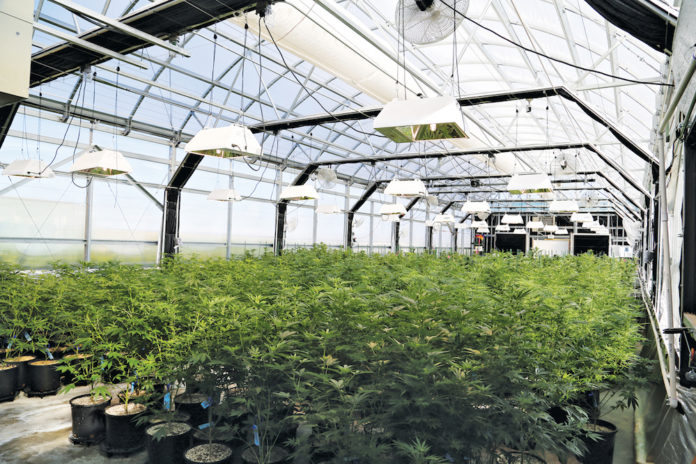In colder climates, greenhouse growers can see profits take a dip. Without a doubt, this largely is due to the hefty cost of heating. Even for the most experienced grower, an increase in monthly heating costs can quickly raise an operation’s cost per gram, but growers have options to mitigate heating costs and bring their cost per gram back within a reasonable and profitable range.
The key to improving winter heating is maximizing efficiency while minimizing heat loss. Many growers address only one of these factors and are then perplexed when February’s heating bill is too expensive. Growers can do three things to truly address both factors: design an efficient heating system, use proper greenhouse covering, and integrate energy screens into the structure.
Efficient heating systems
Utilizing an efficient heating system is one of the most important aspects of successful year-round production. While a number of heating options are available, growers first should look into a radiant heating system. These systems allow growers to maximize efficiency; when used properly, they can significantly cut costs.
Heat radiation functions a lot like light: Waves move in a straight line and when they reach an object are either reflected, transmitted, or absorbed. In a radiant system, heat is transferred to crops without the need for direct contact.
Commonly referred to as floor heating systems, radiant systems create an even and uniform temperature, which growers love because they don’t have to deal with spots that are too hot or too cold. Most radiant systems distribute heated water throughout the flooring to create an ideal growing environment. The systems utilize a boiler and a series of tubes laid under the floor. Water is continually recirculated through the tubing and boiler, so it maintains a consistent temperature.
It’s important to note radiant systems work best with concrete slabs and, in most cases, aren’t the best option for greenhouses with gravel flooring. Will Kacheris, who designs custom greenhouse systems for GrowSpan Greenhouse Structures, emphasized this point: “The concrete floor acts like a large energy buffer, retaining the energy that is put into it so it can radiate out during the night and prevent temperature swings.”
Even growers who don’t have concrete flooring can take advantage of radiant heating. Tubing for the system can be installed under greenhouse benches so heat is delivered directly to the root zone.
Radiant heating becomes even more efficient when boilers run on natural gas or waste wood. Some growers take an additional step, scrubbing waste fumes from the boiler and then pumping the CO2 back into the greenhouse, further enriching the greenhouse environment and potentially boosting yields.
For those not looking to install a radiant system, Kacheris recommended a different type of economical system. “High-efficiency hanging units fired by propane or natural gas are now up to 93-percent efficient, and [these units] can [make up for] for the increased upfront cost in just one winter.”
Adding hanging units may be an easier way for some growers to improve their heating efficiency, and since growers may recoup their return on investment quickly, they’re a decent alternative to a radiant heating system.
Greenhouse coverings
While an efficient heating system will help growers improve greenhouse temperatures, the benefit of such systems is drastically reduced if the structure leaks a lot of heat. To minimize heat loss, growers must examine the construction of their greenhouses. Specifically, the greenhouse cover plays a major role in heat-retention.
To determine the best cover for the application, cold weather growers should pay attention to the R-value of the cladding. The R-value gives a numerical value to the thermal resistance of a greenhouse cover. The higher the R-value, the more insulation it will provide.
Greenhouse coverings are of particular interest in the cannabis industry because several operations have stepped away from more-traditional, clear-sided structures. For many operations, this is largely due to the superior R-value of steel sidewalls, which are double-layered and filled with insulation. It’s important to point out that while these sidewalls ensure exceptional insulation, they also inhibit natural light.
Numerous options exist for growers who want to maximize natural light. The best covering for these growers is eight-millimeter twin-wall polycarbonate. This covering allows light to filter through while limiting heat loss. Polycarbonate frequently is compared to glass, but its R-value is nearly two times higher and it weighs less, making it easier to install and work with.
Energy screens
Energy screens support both heating efficiency and insulation. Most curtains run at or below the gutter line, so they separate rafter space from the rest of the structure. This helps heat efficiency by reducing the amount of space that requires heating.
Energy screens also create a second thermal barrier, making it more difficult for heat to escape the structure. Most growers wish to maximize light to their crops during the day and so only deploy energy screens at night in order to combat colder nighttime temperatures.
Curtain systems can be completely automated—thus free of any labor costs—and when used properly, many growers realize an energy bill savings of 30 percent.
But wait, there’s more
By utilizing efficient heaters, selecting the right greenhouse covering, and using energy screens, growers will not only improve heating efficiency and reduce heat loss, but also increase wintertime profits. If that isn’t reason enough to make a change, implementation of these systems and techniques may make growers eligible for state or federal energy rebates, according to Kacheris.











